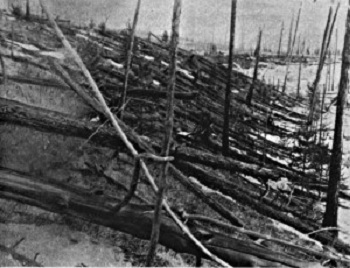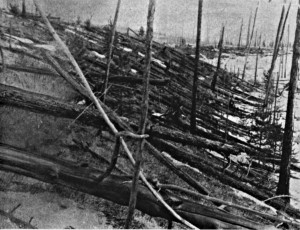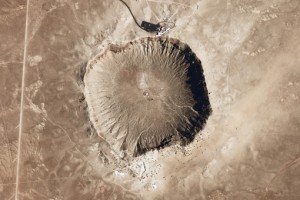Science or fringe science? Removing the ‘giggle factor’ from Near Earth Object impacts

On June 30, 7.17am in a remote, sparsely inhabited area in Siberia, Russia, near the Podkamennaya Tunguska River, occurred an event of enormous devastation. An asteroid or comet estimated to be 40-50 meters in diameter, exploded at low altitude with an energy almost 200 times that of the atom bomb dropped on Hiroshima. Trees where knocked down over an area of two thousand square kilometres, hundreds of reindeer where killed and the seismic shock from the airborne explosion was registered on barometers in England. Eyewitnesses 60km away, reported seeing the northern sky covered with fire, followed by an enormous bang, though thankfully no human deaths were recorded.

Dan Yeoman from NASA’s Jet Propulsion Laboratory stated in an interview in 2008, “the Tunguska event is of great importance not only because of the devastation caused to a thankfully remote area, but also as it is the only modern era event of this type where we actually have first-hand accounts.”
While the Tunguska event has been the realm of many alternative, and sometimes rather fanciful theories since 1908, the subject of an asteroid or comet impact with earth was also considered rather far-fetched until quite recently.
The ‘giggle factor’
Two major events helped bring impact events back to the attention of scientists, the media and the public:
The first was the 1970s discovery of evidence leading to the Chixiclub crater located under Mexico’s Yucatan Peninsula. This crater is thought to have been caused by an enormous impact event 65 million years ago from an asteroid or comet fragment approximately 10 km in diameter. The impact is now widely believed to have been the prime cause of the extinction of dinosaurs 65 million years ago (the Cretaceous-Paleogene boundary).
The second event was the highly publicised and observed 1994 impact of comet shoemaker-levy 9 with Jupiter. Before these events, the thought of any large impact event and much less the planning for a systematic detection and tracking system of Near Earth Objects (NEO’s) was regarded as somewhat alarmist and even a kind of fringe science best dealt with by science fiction writers by many in the scientific community. In the words of the famous comet finder David Levy “these events removed much of the ‘giggle factor’ associated with impact events”.
Now before we start panicking
The NEO’s consist of rocky meteoroids, asteroids and icy comets that cross earth’s orbit or orbit within earth’s neighbourhood. Small NEO’s enter the earth’s atmosphere frequently, with NASA’s Near Earth Object Program estimating that 100 tons of dust and sand size particles burn up in our atmosphere each day-we see these as meteors or ‘shooting stars’. At the other end of the scale, impact of much larger NEO’s that can cause local, regional and global devastation over land (resulting from a low altitude airburst, or a ground impact for large objects causing a crater) or sea (resulting in a tsunami) are much rarer. For instance, Chapman and Morrison reporting in the journal Nature, estimated that objects over 1.5 km – enough to cause global devastation and many millions of casualties- impact the earth on average once every 500,000 years, corresponding to a risk dying from an large impact event over a 65 year lifespan to a 1 in 20,000 chance.

Thus the risk of experiencing a large damaging impact over a human lifetime are extremely small, however the catastrophic nature of these impacts means that it is a very good idea to keep an eye on our rocky and icy neighbours…… as while the timeframes are long, the frequently repeated maxim of: “it is not a case of if, but when” is indeed relevant here.
The Spaceguard Survey
Enter the Spaceguard survey – the umbrella program begun in 1998 and used to describe the loose affiliation of surveys using telescopes to detect and track near earth objects, and assess their hazard to earth. Originally the goal of Spaceguard was to detect and track 90% of NEO’s over 1 km (ie. capable of causing global devastation), but since 2005, a new NASA directed goal has been to now detect 90% of NEO’s over 140 m by 2020.
NEO’s identified by programs such as Spaceguard, and here in Australia by our own survey located at the Siding Springs Observatory (part of the Catalina Sky Survey), are classified according their risk to earth using a numbered and coloured scale known as the Torino scale. This ranges from 0 for comets and asteroids that pose no hazard, to a 10 for a certain collision with a large asteroid or comet capable of causing global climactic catastrophe-very literally a threat to civilisation.

With our improvements in detection and tracking come the inevitable media accounts of ‘near misses’ with NEO’s or reports of possible future impacts. One example is the asteroid 2011 AG5, a large 140 m diameter asteroid which was widely reported as posing an impact threat to earth in 2040. However, for 2011 AG5 to be a potential threat it would have to pass through what astronomers call a gravitational ‘keyhole’ in 2023. If it passes through this keyhole, earth’s gravity may deflect it enough to set it up for an impact with earth in 2040. Recent data however shows that there is a less than a 1% chance of this happening, with Lindsay Johnson of NASA’s NEO program stating “that given our understanding of the asteroid 2011 AG5’s orbit, there is a very low chance of this keyhole passage happening.” Scientists are taking no chances though, and as with all identified potentially hazardous asteroids plan to continue tracking and assessing its hazard to earth.
This brings us to another question, what happens if an NEO is determined to have a high probability of hitting earth – can we stop it?
The answer is probably if we find it in time. Some discussion and study has been undertaken on concepts to deflect a threatening NEO’s orbit away from potential impact with earth. Associate Professor of Physics at New York University Gregory Matloff suggests that diversion is a much more appropriate strategy than destruction, as an asteroid or comet literally blasted to pieces may just end up ‘showering the earth in debris’. Diversion strategies include the detonation of nuclear weapons near the threatening asteroid or comet to divert its orbit away from an impact with earth. However, it may take an actual serious NEO threat before any deflection strategies are prepared. Thus, early detection of threats through programs such as Spaceguard, are essential to provide adequate time for us to plan on how best to tackle the problem.
With so many other issues to be concerned about, such as climate change, disease and more common natural disasters that affect humans and all life on earth on a daily basis, worrying about asteroid and comet impacts may seem trivial – and certainly we should not lose sleep over it. However the knowledge that large impacts do inevitably occur and will sometime in the future threaten earth, means that such threats should be taken seriously, especially considering that we are in the fortunate position of being able to detect and almost certainly act on NEO threats – unlike the majority of natural disasters.
References:
National Aeronautics and Space Administration 2008. The Tunguska Impact-100 years later. Article online: http://science.nasa.gov/science-news/science-at-nasa/2008/30jun_tunguska/
National Aeronautics and Space Administration 2012. Near Earth Object Program. Available online:http://neo.jpl.nasa.gov/
Bailey NJ et al. 2010. Global vulnerability to near-Earth object impact. Risk Management 12(1): 31-53.
Bland PA. 2005. The impact rate on Earth. Phil Trans R Soc A 363:2793-2810.
Chapman CR and Morrison D. 1994. Impact on Earth by asteroids and comets: assessing the hazard. Nature 367(6458):33-39.
 Follow
Follow